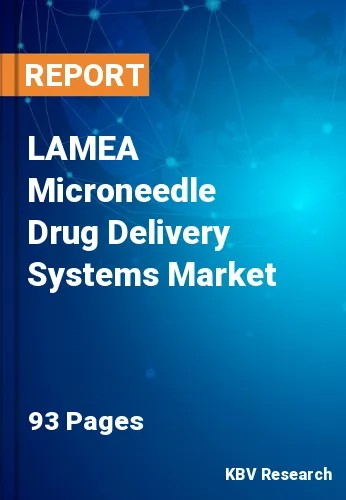The Latin America, Middle East and Africa Microneedle Drug Delivery Systems Market would witness market growth of 8.8% CAGR during the forecast period (2021-2027).
Microneedle patches are developed in a manner that even less-skilled and less-trained workers can administer these patches to simplify the process of distribution, disposal, and storage. Based on the report by WHO, it is anticipated that there will a significant surge in the number of cancer cases that would consequently increase the demand for microneedle patches for the drug delivery system. Moreover, the aspects accountable to boost the growth of the microneedle drug delivery system market are growing transdermal drug delivery applications for pain management, hormone replacement, congestive heart failure and developments in technologies like microneedle patches.
However, some of the barriers to the market growth are poor absorption, variability in absorption, drug degradation, and local irritation. The demand for microneedle drug delivery systems is increasing due to the excessive availability of safer options to the traditional hypodermic injection that allows pain-free vaccination delivery and is minimally invasive. In the current scenario, the demand for the COVID-19 vaccine is excessively high, which would create lucrative opportunities for microneedles in the market. Additionally, the rising number of diabetes patients is also contributing to the growth of the market. According to WHO, around 422 million people were suffering from diabetes in 2018 across the world.
The region is witnessing a constant surge in the number of premature infants who are highly vulnerable to stunt growth and catching infections. Therefore, early microneedle administration is crucial for preterm infants and they must receive appropriate amino acids & energy. The market players are capitalizing on this opportunity by actively entering the regional market and putting investments in different strategies in order to gain a competitive edge.
High accessibility with ultra-modern supply chain solutions is expected to fuel the growth of the regional microneedle drug delivery systems market in the upcoming years. Moreover, the adoption of microneedle drug delivery systems has been increased in end-user verticals such as diagnostic centers, hospitals, and clinics in order to avoid infections and to maintain hygiene levels. Hence, these factors would open new avenues for growth for the regional microneedle drug delivery systems market.
The Brazil market dominated the LAMEA Pain Management Market by Country in 2020, and would continue to be a dominant market till 2027; thereby, achieving a market value of $19.7 million by 2027. The Argentina market would witness a CAGR of 10.3% during (2021 - 2027). Additionally, The UAE market is expected to witness a CAGR of 9% during (2021 - 2027).
Based on Type, the market is segmented into Hollow, Dissolving, Solid, Coated, and Other Types. Based on Material, the market is segmented into Metal, Polymer, Silicon and Other Material. Based on Application, the market is segmented into Drug delivery, Cancer Therapy, Vaccine delivery, Pain Management, Dermatology and Other Applications. Based on countries, the market is segmented into Brazil, Argentina, UAE, Saudi Arabia, South Africa, Nigeria, and Rest of LAMEA.
Free Valuable Insights: The Global Microneedle Drug Delivery Systems Market is Predict to reach $9.1 Billion by 2027, at a CAGR of 7.8%
The market research report covers the analysis of key stake holders of the market. Key companies profiled in the report include AdminMed nanoBioSciences LLC, Becton, Dickinson and Company, Zosano Pharma Corporation, Raphas co. ltd., Nanopass Technologies Ltd., Corium International, Inc., Gurnet Point Capital), Valeritas, Inc. (Zealand Pharma), Nitto Denko Corporation, Endoderma Ltd., and Innoture Medical Technology Limited.
By Type
By Material
By Application
By Country
Our team of dedicated experts can provide you with attractive expansion opportunities for your business.

